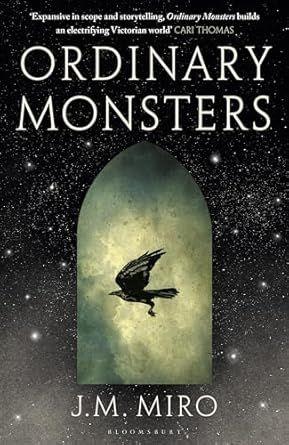
For all things fantasy, horror, and speculative fiction

Review Details
Review type: Book
Title: Ordinary Monsters
Author: J.M. Miro
Publisher: Bloomsbury Publishing

Reviewed by: T Nagarajan
Other details: Paperback; £9.99
Ordinary Monsters by J.M. Miro
Book Review
T Nagarajan
Read the summary of Ordinary Monsters, and you may feel that this is the same story we have seen on the silver screen or read in many other books. However, I urge you not to judge the book by its blurb. I initially picked up this monster of a book because the story promised to be familiar – after a lengthy hiatus from reading (and sticking mainly to audiobooks), I resolved to get back into reading hard copies.
Ordinary Monsters was not what I expected at all. It is the first in a proposed trilogy of books that centres around a group of young, gifted children, a.k.a. “talentsâ€, who discover self-reliance and friendships formed through the crucible of this inaugural tale.
And crucible it is. The imagery reminds me of something that Stoker would have written, combined with syntax, which is much more contemporary. This is a hard read – not because it is badly written, but because it is very dark. So dark, in fact, that I had the same feeling reading this as I did when I played Demon’s Souls for the first time (for those of you who have experienced this). It is relentless, with a background brooding malevolence that weighs down any feel-good parts of the story.
The narrative unfolds through the eyes of many different characters, focussing on the young “talentsâ€. Whereas this technique will sometimes interrupt the flow of a story, Miro has managed to get the balance here spot on. The story links seamlessly from one phase to the next to slowly unpeel a rich background and a connection to the characters where the gambit feels real. However, the author, I think, tries to be a little bit too clever in terms of the twists they employ. The characters are motivated by their beliefs and perceptions rather than any notion of ‘good’ or ‘evil.’ It is more of a story of innocence versus exploitation, which leads to edge-of-your-seat ambiguity for the majority of the novel. You are never quite sure who the bad guy is – whereas this works very well throughout the majority of the book. By the time I had a quarter of the book left, I was left vaguely wishing the true antagonist was a little better signposted. The motivation of one or two of the characters, in particular, could have been made a little more explicit – by the time I finished reading this book, I was sure I had missed something important.
Despite my foibles, I thoroughly enjoyed this read. It is not a light-hearted jaunt, but with a little dedication, you will be rewarded by the time you are done. I personally am looking forward to book two!
Tags: AdventureBloomsbury PublishingFantasyHorrorJ.M. Miro
Category: Book Review
All reviews
Latest Reviews:
- Girl Dinner by Olivie Blake
- The Swan’s Daughter by Roshani Chokshi
- Out of the Past, Tales of Haunting History edited by Aaron Worth
- Witchborne by Rachel Grosvenor
- Shattered Reality . Call of Cthulhu Scenario Anthology
- The Flesh King by Richard Kadrey
- The Haunted Vintage Marjorie Bowen
- Daughters of Nicnevin by Shona Kinsella
- Katabasis by R. F. Kuang
- Opposite World by Elizabeth Anne Martins
Review tags:
Action (48) Adventure (69) Angry Robot Books (11) Contemporary Fantasy (15) Fantasy (116) Gothic Horror (12) Harper Voyager (12) Historical Fantasy (14) Hodderscape (11) Horror (71) Orbit Books (33) Romance (28) Science Fiction (34) Titan Books (35) TorDotCom (12)
Leave a Reply